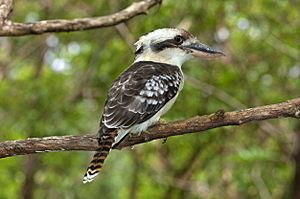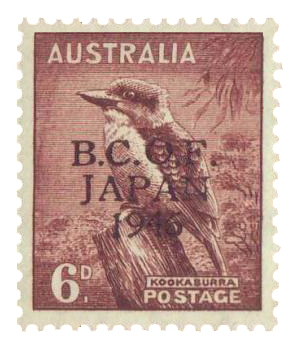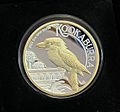Kookaburra facts for kids
Quick facts for kids Kookaburra |
|
|---|---|
 |
|
| Dacelo novaeguineae | |
| Scientific classification | |
| Kingdom: | |
| Phylum: | |
| Class: | |
| Order: | |
| Family: | |
| Genus: |
Dacelo
Leach, 1815
|
Kookaburras are a type of tree kingfisher found in Australia and New Guinea. These birds can grow to be about 28 to 42 centimeters (11 to 17 inches) long. Their name comes from the Wiradjuri language word guuguubarra.
The laughing kookaburra is famous for its loud, unique call. It sounds a lot like human laughter! You might have heard this sound in movies, especially older ones, when they want to show an Australian bush or jungle scene.
Kookaburras live in many different places. You can find them in wet forests, dry grasslands, and even in towns. They like areas with tall trees or near running water. Even though they are kingfishers, kookaburras don't usually live near water or eat fish like other kingfishers do.
Contents
What Kookaburras Eat
Kookaburras are mostly meat-eaters, which means they are carnivorous. Their diet includes small animals like mice, snakes, insects, and tiny reptiles. They also eat the young birds of other species. Unlike many other kingfishers, kookaburras rarely eat fish. However, they have been known to snatch goldfish from garden ponds!
In zoos, kookaburras are usually fed special food meant for birds of prey. If you ever see a kookaburra, it's best not to feed them ground beef or pet food. These foods don't have enough calcium and roughage, which are important for a kookaburra's health.
Kookaburras are very social birds. They might even take food right from your hand or from a barbecue if they are used to people.
Kookaburra Territory
Kookaburras are very protective of their home areas, which means they are territorial. They often sing together in a group, like a chorus, to let other kookaburras know that this territory belongs to them. This loud singing helps them mark their space.
Kookaburra Conservation
All types of kookaburras are currently listed as "Least Concern" by conservation groups. This means they are not in danger of disappearing. In Australia, laws protect native birds, including kookaburras, to help keep their populations healthy.
Kookaburras in Culture
The unique sound of the laughing kookaburra's call is very popular. It's often used in movies and TV shows to create a jungle or bush atmosphere. You might even hear it at some Disney theme park rides, even if the setting isn't Australia!
A kookaburra named Olly was one of the three mascots for the 2000 Summer Olympics in Sydney, Australia. The other mascots were Millie the echidna and Syd the Platypus.
There's an Australian character named "Kookaburra" (or "Kook") in the children's TV show Splatalot!. His costume has wings like the bird's, and he's known for his high-pitched laugh.
Australia also makes a special coin called the Australian Silver Kookaburra. These silver coins have been minted every year since 1990.
For many years, the call of a kookaburra nicknamed "Jacko" was used as the morning theme song for ABC radio stations in Australia. It was also used for Radio Australia's broadcasts to other countries. This famous kookaburra even inspired a children's book!
You might know the popular children's song "Kookaburra sits in the old gum tree". This well-known song was written in 1932 by Marion Sinclair.
Kookaburra Postage Stamps
Kookaburras have appeared on many postage stamps over the years:
- A six pence stamp featuring a kookaburra was released in 1914.
- A three pence Australian stamp was made in 1928 for a stamp exhibition in Melbourne.
- Another six pence stamp was issued in 1932.
- In 1990, a 38¢ Australian stamp showed a pair of kookaburras.
- An international $1.70 Australian stamp with an illustrated kookaburra was released in 2013.
Images for kids
-
A male blue-winged kookaburra.
See also
 In Spanish: Cucaburras para niños
In Spanish: Cucaburras para niños









